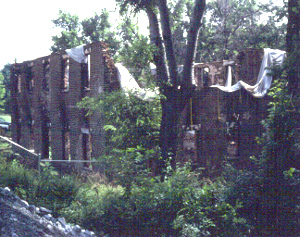
Lenoir Cotton Mill
The Lenoir Cotton Mill was one of a series of five mills built by the family of General William Lenoir along Town Creek in what is now Lenoir City. In 1810 Major William Ballard Lenoir, son of Revolutionary War General William B. Lenoir, arrived with his family to occupy a five-thousand-acre military grant given to his father. He developed the land, known as Lenoir’s Station, into an important commercial and manufacturing community. The first industrial structure on the site was a burr and roller flour mill with a 150-barrel capacity. By 1834 the site included a cotton mill built with slave labor. At one time, the large brick structure was equipped with one thousand spindles producing cotton yarn and batting. Cotton fiber to supply the spindles was imported from states in the lower South. Lenoir built his home, which still stands, close to the mills.
When the Civil War arrived in East Tennessee, the mills came to the attention of General Ambrose Burnside. A force of approximately 1,500 men under the command of Colonel W. P. Saunders arrived at Lenoir’s Station on June 19, 1863, and burned the general store, the railroad depot, and a quantity of military stores. As they prepared to burn the cotton mill, Dr. Benjamin Ballard Lenoir, the son of the mill’s founder and an active Mason, moved among the troops giving a secret Masonic sign. The mill was spared and continued in operation into the late nineteenth century. In the 1890s the Holston Manufacturing Company used the building to house a hosiery mill. The mill was then converted to a flour mill and continued operation until the 1950s. The building eventually became the property of Lenoir City and remained unused for many years.
The building was included in the Historic American Buildings Survey as an early and unique example of industrial architecture and placed on the National Register of Historic Places in 1976. The building reflected the naive and unpretentious indigenous architecture of the time which grew out of two contradictory forces, progress and romanticism. Some of the internal structure, particularly the unique placement of brick abutments within the walls to serve as landings for the internal beams, is considered to have been far ahead of its time.
In 1980 the American Studies Class at Lenoir City High School, with support from interested citizens, formed the Lenoir Cotton Mill Association (LCMA) to preserve and restore the historic building. The organization raised over one hundred thousand dollars and completed a number of restoration projects before arsonists burned the structure in 1991. In 1996, after the Lenoir City Council rejected a revised plan to rebuild the mill, the LCMA approved a plan to protect the site and preserve the ruins of the building.



